Among the Indian women of America the arts and crafts took a prominent place as an occupation and as a source of pleasure. Needlework and other arts that employed the same technical process were among the arts most cherished and cultivated by Indian women. Among certain tribes of North America a form of embroidery commonly called quillwork became highly developed and is much admired today. By means of this art the Indian women got results much better than the later day beadwork which came into use only after the coming of the white man.
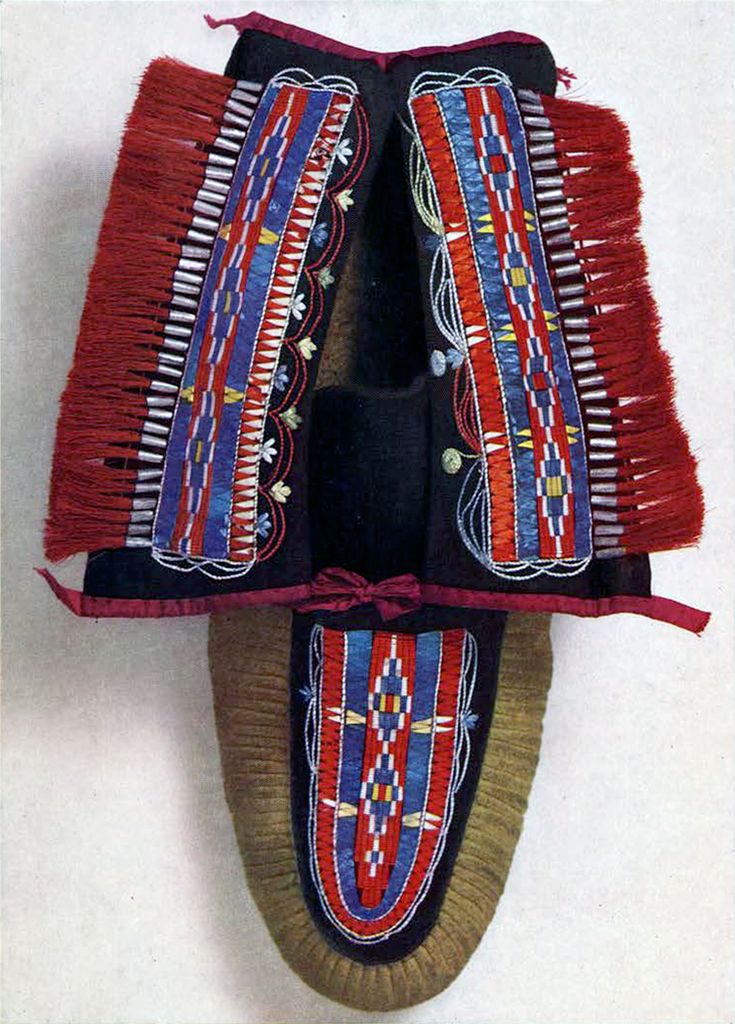
Museum Object Number: NA4946
She had learned to use the dyed quill of the porcupine and thus had developed a distinctive American art, an art not existing in any other part of the earth. In fact, the art of quill decoration seems to be almost the only fine art which is unique in occurring only in North America.
Many of the methods used in applying the quills were readily adapted for work with beads so that many of the operations were bodily taken over and very similar results obtained. Work with beads was faster and easier, so it was not long before the quillwork began to deteriorate. Most of the specimens of the early technique in quillwork have disappeared.
It is unfortunate that most of the best pieces of quilling extant were collected so long ago that there remains little information regarding their makers or the meanings of the designs. Moreover, the regions where the natives used the porcupine quills for decoration are not confined to the habitat of that animal. The Cheyenne and Arapaho are several hundred miles from any place where the porcupine could be hunted, and yet these tribes used vast amounts of quills. These were obtained by barter from those tribes living in the habitat of the porcupine. Among many tribes quills served as a medium of exchange similar to the dentalium shells of California or the wampum of the North Atlantic states.
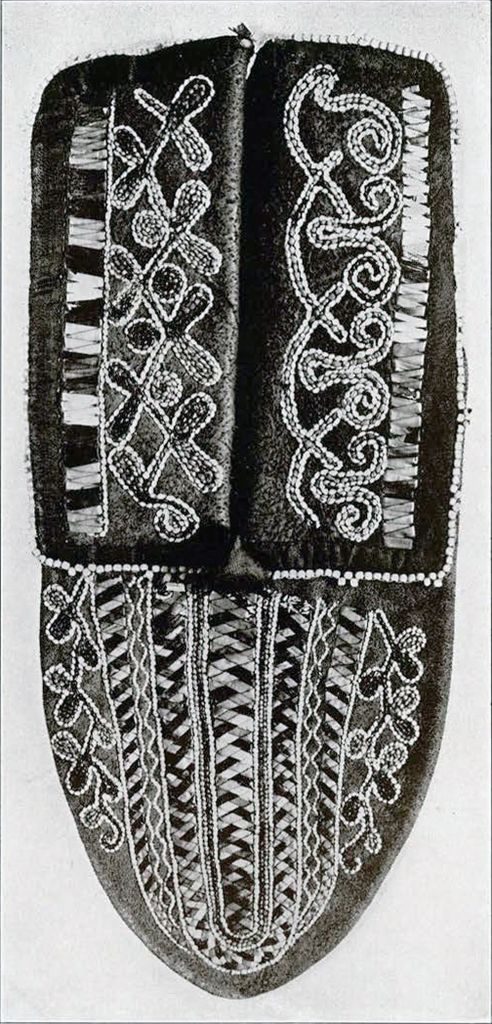
Museum Object Number: NA4945
Image Number: 12976
Hunting the porcupine was the duty of the men who “treed” and shot it, trapped it, or else dug it out of its burrow. In the last case it was sometimes caught in a tanned skin or blanket and held while its quills were plucked out and then allowed to go. Usually it was killed and roasted entire like a suckling pig, being esteemed a great delicacy.
The women sorted the quills according to size and then dyed them by boiling in some sort of vegetable dye. Reds, blacks, yellow and more rarely green, a faint blue and a dark purple were used. Tamarack bark, spruce cones, and several varieties of berries were used to produce red. Walnuts and wild grapes furnished blacks of different qualities. Wild sunflower, the cornflower, pine bark, and willow root supplied the yellows. Blueberries and larkspur gave different shades of blue. Many other plants gave different shades of these colors. The Indian woman had to be well versed in plant lore to secure the desired dyes.
Many methods of working were devised and complex foldings and stitches were employed to develop different symbolic designs. The only implements used even in the most intricate work were an awl and sometimes a piece of bone to flatten the quills. Some sinew thread and usually some bark or leather patterns were also necessary.
The Museum possesses some fine examples of quillwork. The moccasin, Plate II, is one of the best examples of this unique American art in existence. It is one of several similar pieces given to the University Museum by Mrs. W. H. Miller of Media. Several different techniques are well illustrated in this specimen. The simplest is based upon narrow lines of quilling forming a series of curves and rosettes, which makes a very pleasing border for the body of the ornamentation. Incorporated in this border is a number of three-pointed floral elements showing a second method of applying the quills. The next row of quill work is rather broad and shows a very interesting and ingenious method of folding the quills. The top edge of the left flap shows a variation of this by which a pretty effect is produced by using red and white quills together. Elsewhere in similar bands this modification is used for short spaces; for instance, in the blue bands where yellow quills are introduced to relieve the monotony of a solid color.
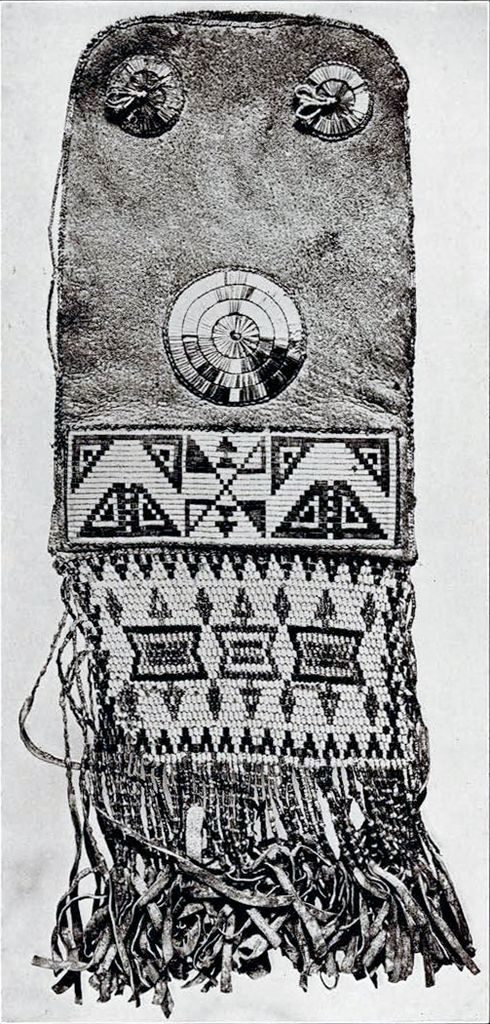
Museum Object Number: NA5217
12956
The central panels of the decorations show perhaps the most cleverly contrived of all the methods of quillwork ornamentation. They appear to be made up of a large number of minute cylindrical pieces of quill which have been strung like beads to form a geometric design. Even upon examining places where the quills have been worn through, one receives the same impression, but upon close examination it is found that the entire piece is ingeniously and carefully woven and that it is the flattened quill nearly surrounding the woof thread that gives the beadlike appearance. This weaving was a very slow process and only the finest of the quills were used. These had to be matched in size and it is very remarkable how uniform they are in any one pattern. The beadlike rows in this pair of moccasins are almost exactly fourteen to the inch.
With its brilliant colors, red, white, blue, yellow, and green, skillfully blended together on a background of dead black deerskin, this specimen is worthy of a place in any collection of art objects whose selection depends upon their coloring and beauty of execution.
Another noteworthy pair of moccasins, Fig. 13, also given by Mrs. Miller, presents still another way of applying the colored quills. The principal new method is found best shown in the central stripe running down the toe. This is a system of plaiting in which each quill passes two others and is caught at the sides of the band by a concealed sinew thread. A very pleasing effect is here produced by combining the quills so that the different colors predominate in some especial places. Near the instep red is prominent, at the middle red, blue, and yellow are equally displayed, while near the toe the greenish blue is most manifest. Floral designs and the double curve motive characteristic of the Northeast United States are produced by combining three or more lines of quilling. In this the same technique found in the preceeding moccasin is employed.
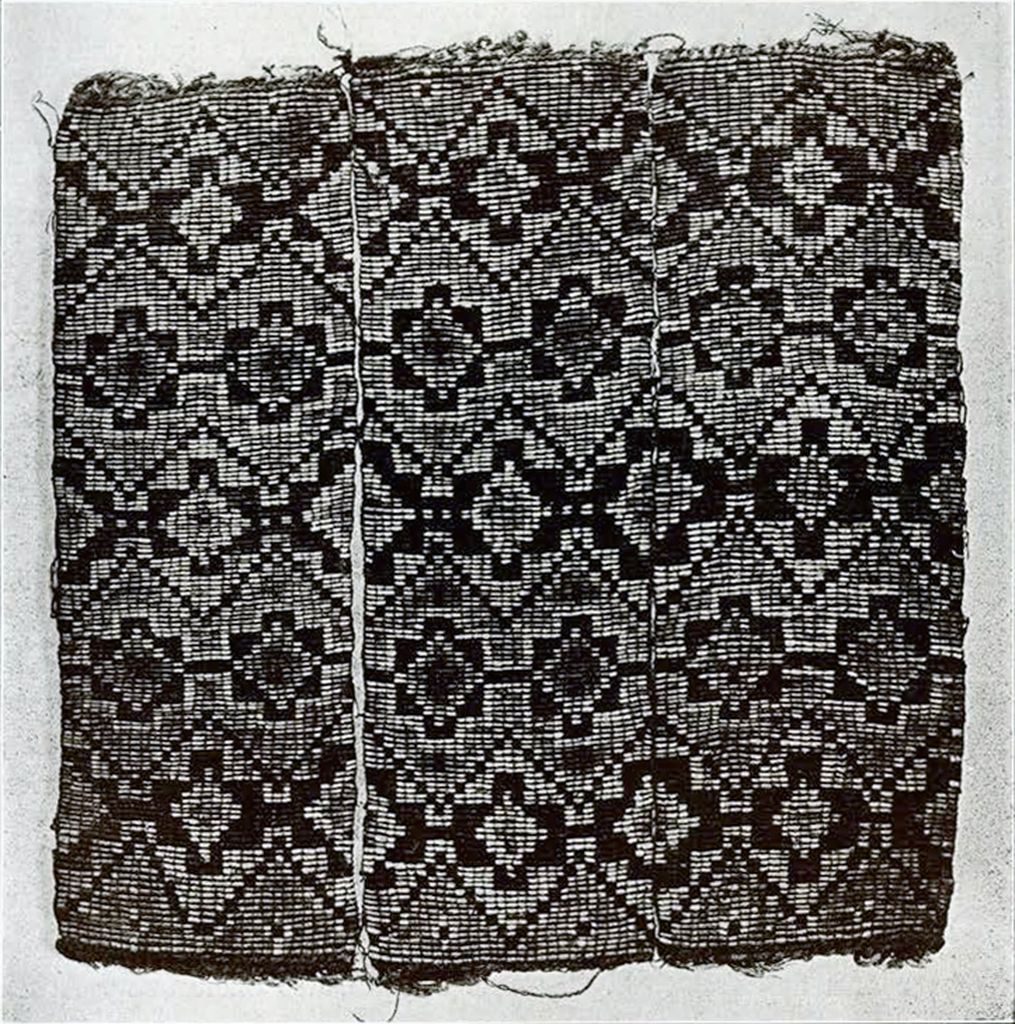
Museum Object Number: 38355
Image Number: 13416
In many ways this pair of moccasins compares very favorably with the preceding. The method of plaiting and the method of stitching used to produce the floral and curved elements, certainly shows aboriginal embroidery with quills had reached a very high state of perfection. In profusion of color also this pair equals the first. In delicacy of treatment, however, it does not approach the woven quillwork.
The pouch, Fig. 14, shows the results of a long period of painstaking work. The band of woven work with its symbolic designs is very evenly and carefully made. The rosettes above this band are cleverly and artistically made and to the maker at least conveyed some meaning probably connected with the sun or the morning star. Part of the fringe at the bottom is cleverly wrapped with quills to produce a netlike background containing diamond and spool shaped designs. Below this the strands are wrapped in pairs for a couple of inches and then allowed to hang free.
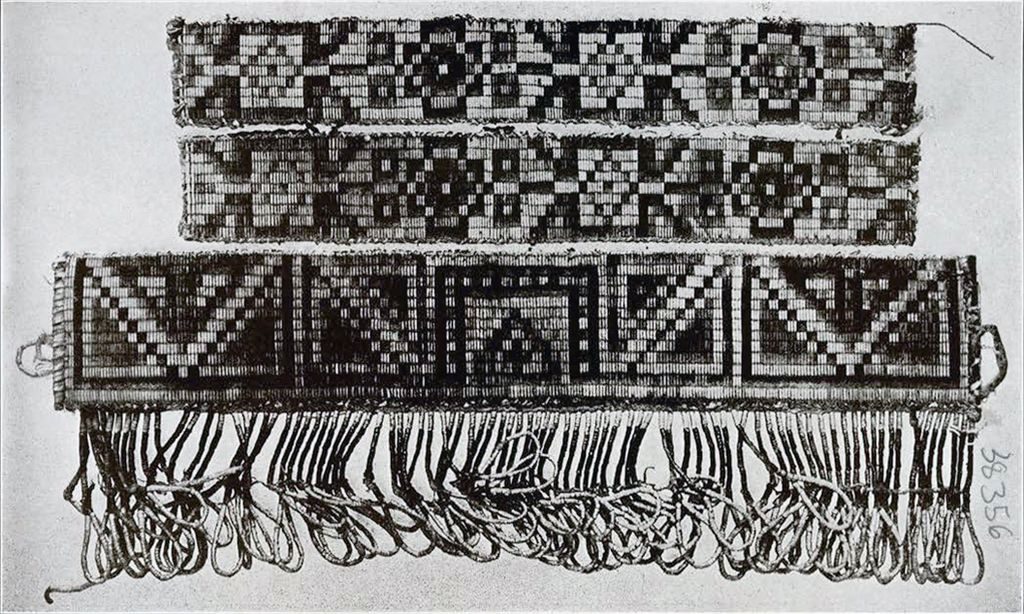
Image Number: 13417
Perhaps the oldest and best piece of quilling is one of four pieces collected by George Catlin, the pioneer collector and painter, who was among the Indians in various parts of the United States from 1832 to 1839 studying them as they then were. Later these specimens found their way into the Thomas Donaldson Collection, from which, through the generosity of Mr. John Wanamaker, they were acquired by the University Museum. The workmanship of this piece, Fig. 15, does not now appear to be of the highest type, doubtless because age and handling have allowed some of the strands to slip and become loosened. In its coloring and designs this piece stands pre-eminent. The coloring has a richness and softness that only age and the old native dyes could possibly produce. The different colors, red, black, white and yellow, are artistically blended into very well proportioned and complex patterns, far more elaborate and effective than the stepped triangles and pyramids usually found in the woven quillwork.
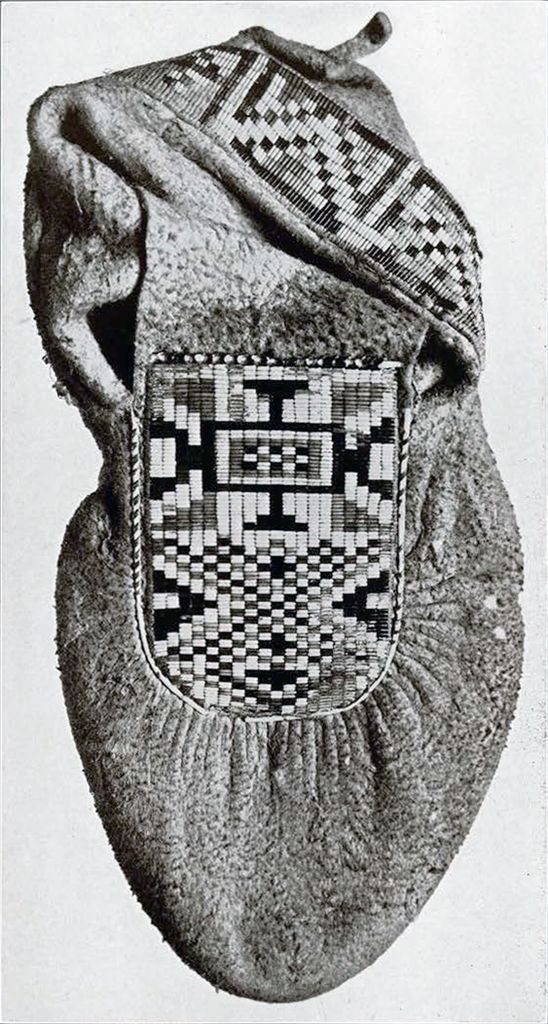
Museum Object Number: NA5216
Image Number: 12950
Very rarely it happens that some old Indian woman will know the methods and take the care and time necessary to do good quill-work. Especially is this true among the seldom visited Cree and Loucheux Indians of Canada. One coat procured a few years ago by Dr. G. B. Gordon, the Director of the Museum, shows probably the most delicate and precise work in the collection. It is so seldom of recent years that the best grade of work is produced that this coat is almost as rare as the majority of the very old specimens.
Besides the articles mentioned, quills were used to decorate the calumet or peace pipe stems which played such an important part in the life of the Indian. Many new and complex methods of attaching quills are found in the ornamentation of baby carriers, clothing and other objects. Birchbark boxes gayly decorated with quillwork are still made and sold by Indians as curios.
When the drudgery and hard work that fell to the lot of the squaw are considered, it is indeed remarkable that she was able to originate and develop so highly this unique and exclusively American Art.
B. W. M.

